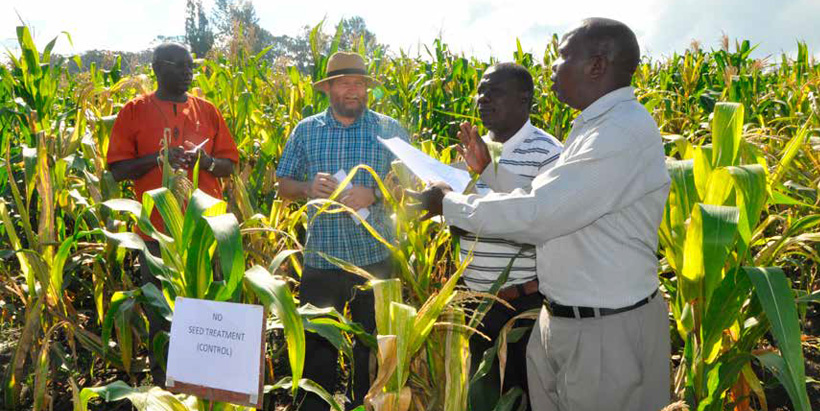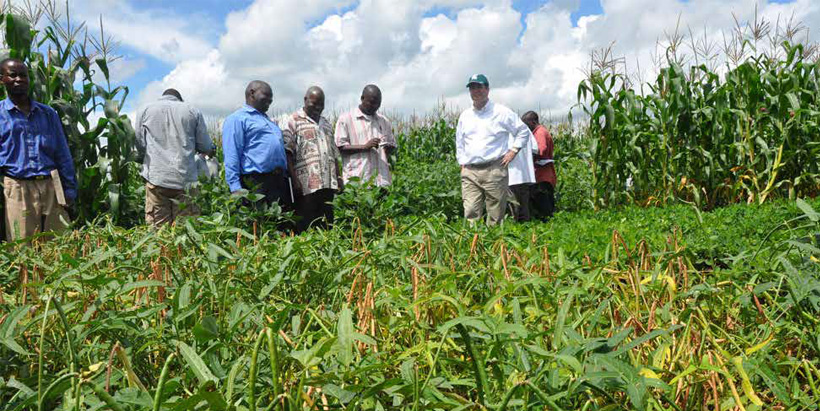Taulya Godfrey, Ochola Dennis, Najjuma Zahara, Jabungu Allan, Nakamanya Florence, Senyondo Brian, Kubiriba Jerome
East African highland bananas are the major food crop for 20 million people in the Great Lakes region of Africa, encompassing Burundi, DR Congo, Kenya, Rwanda, Tanzania, and Uganda. They are widely traded in local markets, contributing to the monetization of rural economies and sustaining the livelihoods of resource-poor farmers.
Poor soil fertility exacerbated by low input production practices has contributed significantly to low and declining productivity of East African highland bananas. Manure is the soil fertility input used by relatively rich farmers, compared to no fertility input by the poor farmers who are the majority. However, manure application is labor intensive and is scarce in most banana-growing areas of Uganda.

This project sought to develop an alternative nutrient management practice that is less laborious yet cost-effective in a farmer participatory manner with relevant stakeholders to ensure rapid scaling up and scaling out. IITA partnered with Wageningen University and GrainPulse to demonstrate integrated mineral and organic input practice in farmers’ banana fields in Uganda’s major banana growing areas. The National Agricultural Research Organization (NARO) leads the project with funding from the Bill & Melinda Gates Foundation. Farmer choice experiments led by Wageningen University and IITA were used to allay farmers’ reluctance to using mineral fertilizers in East African highland bananas in Uganda. It was observed from the farmers’ choices that they tended to combine cattle manure with mineral fertilizers as fertility inputs in banana cropping systems. A follow-up on-farm experiment was designed with various combinations of cattle manure and potassium chloride fertilizer in southwestern and western Uganda.

These trials showed that banana response was strongest when mineral fertilizer was combined with cattle manure (Fig. 1). Fresh bunch weight increased the most (18%) with a 50%:50% combination of cattle manure to mineral fertilizer as potassium chloride in southwestern Uganda. Sole mineral fertilizer posted an equally strong response in southwestern Uganda, where the trial fields had a history of manure use. In contrast, almost all the trial farms in western Uganda had no previous history of manure application, and crop response to sole mineral fertilizer was less than expected (Fig. 1). In western Uganda, the most significant increase in fresh bunch weight (36%) was observed with a 75%:25% combination of cattle manure to potassium chloride (Fig. 1).
Farmers observed that the application of soil fertility inputs shortened the time taken for a banana plant to bear a bunch to maturity. This amplifies the increase in yield due to improved fresh bunch weight. Based on the findings from the on-farm trials in Figure 1, on-farm demonstrations were set up with cattle manure at half the rate farmers use, supplemented with half the recommended dose of potassium from mineral fertilizer. This was compared against the use of sole manure at the farmers’ full dose, with no soil fertility input or control on established farmers’ fields. Combining a half dose of manure with a half dose of mineral fertilizer increased fresh bunch yield by 53% in southwestern and 8% in central Uganda over the control (Fig. 1).

The combination of manure with mineral fertilizer halved the labor input cost for fertilizing bananas compared to using only a full dose of manure. The net cost (excluding investments in other agronomic practices likeweeding) associated with combining a half dose of manure and a half dose of mineral fertilizer was 25% lower than the cost of applying only a full dose of manure. The women farmers, who are both cash- and labor-constrained, particularly appreciated this, according to feedback from farmers during the field days held on the demonstration plots.
Combining a half dose of manure with a half dose of mineral fertilizer increased the return on investment of the soil fertility inputs to US$500 per hectare per year over that for the full rate of manure only at the responsive site in southwestern Uganda. The crops in central Uganda were less responsive to the soil fertility inputs partly due to intercropping with beans and coffee. The return on investment in soil fertility inputs was higher (US$281 per hectare per year) for half the manure dose combined with half the mineral fertilizer dose than for the full dose of manure alone ( US$387 per hectare per year) relative to the control.
However, soil fertility input use had the same benefit, whether the full dose of manure alone or a combination of manure and mineral fertilizer at half dose each: the cost ratio was above 1. This outcome implies that both technologies demonstrated to the farmers on both sites do not pose a financial risk either way.

The observed positive effect of the mineral fertilizer supplement to half dose of manure led some farmers in central Uganda to apply the mineral fertilizer to the control plots, thus masking the treatment effects (Fig. 2). Doing this also partly accounted for the poor estimates of returns to investment in soil fertility inputs in the region.
Two farmer field days around the demonstration plots strengthened information flow between farmers, researchers, and input providers. This increased the demand for the mineral fertilizers at the local dealerships, which started partnering with GrainPulse to secure mineral fertilizers at the factory price, thus reducing the cost incurred by the farmers. The orders for mineral fertilizers from the farmers following the farmer field days amount to application rates more than double the national average application rate. This trend indicates a potential for uptake rates that will outlive the project life span.
GrainPulse operates a fertilizer blending facility that customizes the compound mineral fertilizers to the specific requirements of the crops commonly grown in the farming systems, including bananas. It is receiving information directly from the research team from IITA, NARO, and Wageningen University concerning the specific requirements of East African highland bananas to fine-tune their blends further to the crop
requirements.
Farmers still question the long-term effects of using mineral fertilizers on the soil quality and productivity of East African highland bananas. That question needs to be addressed with data from long-term soil fertility trials.
